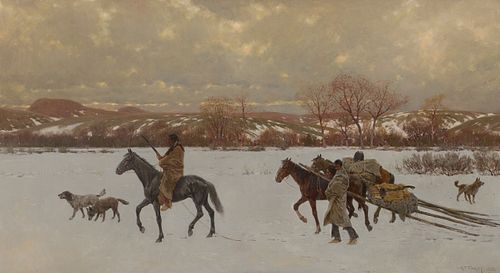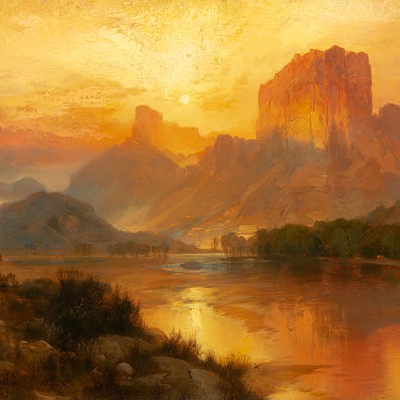Henry Farny (1847-1916); Nomads (1902)
Lot 134
About Seller
Coeur d'Alene Art Auction
11944 North Tracey Road
Hayden, ID 83835
United States
Coeur d’Alene Art Auction specializes in the finest classical Western and American Art representing past masters and outstanding contemporary artists. The auction principals have over 100 years of combined experience in selling fine art and have netted their clients over $325 million in the last fif...Read more
Categories
Estimate:
$1,500,000 - $2,500,000
Absentee vs Live bid
Two ways to bid:
- Leave a max absentee bid and the platform will bid on your behalf up to your maximum bid during the live auction.
- Bid live during the auction and your bids will be submitted real-time to the auctioneer.
Bid Increments
| Price | Bid Increment |
|---|---|
| $0 | $250 |
| $5,000 | $500 |
| $10,000 | $1,000 |
| $20,000 | $2,500 |
| $50,000 | $5,000 |
| $100,000 | $10,000 |
| $200,000 | $25,000 |
| $500,000 | $50,000 |
| $1,000,000 | $100,000 |
About Auction
By Coeur d'Alene Art Auction
Jul 25, 2020
Set Reminder
2020-07-25 15:00:00
2020-07-25 15:00:00
America/New_York
Bidsquare
Bidsquare : Fine Western & American Art
https://www.bidsquare.com/auctions/coeur-dalene/fine-western-american-art-5263
The 2020 Coeur d'Alene Art Auction to be held July 25 in Reno, Nevada, will feature 264 selections of unparalleled quality in Western paintings and sculpture from historical and contemporary artists such as Charles M. Russell, Henry Farny, Thomas Moran, Edward S. Curtis, Carl Rungius, and more. Coeur d'Alene Art Auction info@cdaartauction.com
The 2020 Coeur d'Alene Art Auction to be held July 25 in Reno, Nevada, will feature 264 selections of unparalleled quality in Western paintings and sculpture from historical and contemporary artists such as Charles M. Russell, Henry Farny, Thomas Moran, Edward S. Curtis, Carl Rungius, and more. Coeur d'Alene Art Auction info@cdaartauction.com
- Lot Description
Henry Farny (1847-1916)
Nomads (1902)
oil on canvas
22 x 40 inches
signed and dated lower right
VERSO
Label, Buffalo Bill Historic Center, Cody, WY
An original letter dated May 3, 1902 from the artist to the original owner will accompany the lot.
The letter states in part, “I have this day shipped by express the picture ‘Nomads’ to your address and trust the same will arrive in good shape and be satisfactory—personally it pleases me—as one of the most sincere things I have perpetrated in this vale of tears.
“But pictures are essentially ‘affaires de gout’—one man likes a color scheme, another wants a crass recitative of facts. I had Loring Andrews and one or two other people of good taste see it—and their comments were of a most agreeable nature to the self esteem of the painter. Your uncle Lars came to see it almost daily whilst it was under way. I hope some day when you are in Washington to bring President Roosevelt and Gen. Miles (not on the same day) to see it as they are both fond of my western pictures—and this one is very much the character of the country where the President had his ranch—I shall send him a photograph of it.
“Should you decide not to take the picture please advise me at once—should it on the (other) hand please you—the price is $1,500.00.”
According to Peter Hassrick, “Henry Farny devoted his talents to creating images of a legend passed. This was no quick decision, for Farny did not venture west until the age of thirty-four, in 1881. That summer, stories of Sitting Bull’s surrender appeared in most newspapers. Since the 1876 Battle of the Little Bighorn the Sioux chief and his small band of followers had eluded capture, rarely knowing a moment of peace yet loathing submission. Their Canadian refuge proved cold, the band was starving, and Sitting Bull’s resolve weakened with tales that his daughter was being held hostage in chains. Upon surrender his poignant words must have stung many. ‘I do not come in anger toward the white soldiers. I am very sad. My daughter went this road. Her I am seeking. I will fight no more. I do not love war, I never was the aggressor. I fought only to defend my women and children. Now all my people want to return to their native land. Therefore I submit.’
“That fall Farny headed west to see Sitting Bull at the Standing Rock Agency, Dakota Territory. Although the prisoner had been removed, the newcomer was intrigued by the scenery and native inhabitants which he encountered. ‘The plains, the buttes, the whole country and its people,’ he ardently declared, ‘are fuller of material for the artist than any country in Europe.’ Farny returned to Cincinnati, his home, with more than memories. He had made sketches, taken photographs, and obtained a variety of Indian accouterments.
“Neither from an ethnographic nor an illustrative vantage point did Farny choose to portray Indians. He placed them in their environment, where they were vital and important, not overwhelming and warlike, and he paid as much heed to the landscape as to the figures.”
EXHIBITED
Whitney Gallery of Western Art, Cody, WY 1983Surface condition is in excellent condition. Painting has been lined. Large spot (about a half-inch in diameter) of inpainting to right of the tail of the horse, on which the Indian is mounted. Specks of inpainting throughout.Condition
- Buyer's Premium



 EUR
EUR CAD
CAD AUD
AUD GBP
GBP MXN
MXN HKD
HKD CNY
CNY MYR
MYR SEK
SEK SGD
SGD CHF
CHF THB
THB












